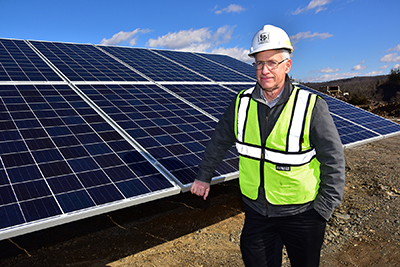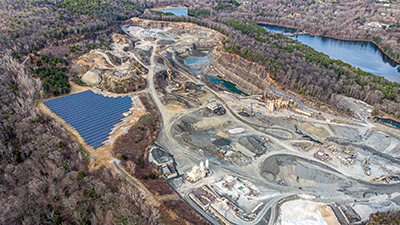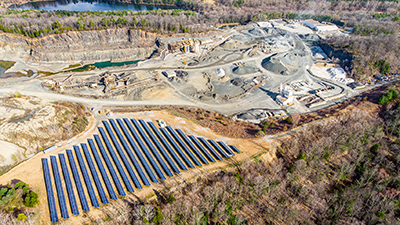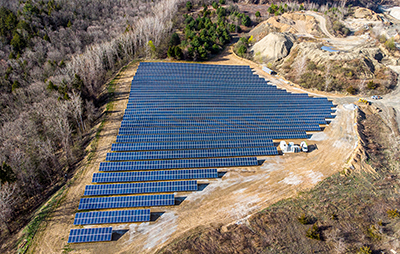O&G Industries Recently Went Live With A 1.3-Megawatt Solar Array At Its Quarry In Southbury, Conn.
By Mark S. Kuhar
O&G Industries, Connecticut’s largest privately held construction company, recently went live with a 1.3-megawatt (MW) solar array at its quarry on Roxbury Road in Southbury, Conn.
The 3,762-panel array is coupled with a 280-kilowatt (kW) Energy Storage System (ESS) that will help to augment supply during peak demand cycles. This includes early morning hours when the sun isn’t strong enough to generate at full capacity while demand at the facility peaks with the startup of the quarry and asphalt plant operations.
The solar array sits on five-acres and will produce the energy equivalent necessary to power 150 homes. The project is one of three solar projects that O&G has developed with the quarry installation being the first of its kind in the state. Solar arrays have also been installed on the rooftops of the company’s fleet maintenance facility in Torrington, Conn. and mason supply showroom in Bridgeport, Conn.
The solar arrays are one of many sustainable and energy-saving initiatives the company has undertaken in the past year. In New Milford, Conn., and Stamford, Conn., among other locations, the company is upgrading burner controls, adding variable frequency fan drives, eliminating air leaks and installing insulation on tanks and piping at the company’s asphalt plants.
When the upgrades are completed, the plants – the first two registered in EPA’s nationwide Energy Star asphalt plant pilot program – are expected to achieve much greater energy efficiency.
The project was completed in collaboration with Eversource, Solect Energy and EnelX.
 |
 |
 |
 |
Why did O&G undertake the project?
We’ve always been environmentally conscious as a company. However, the past two years we’ve increased the focus on green initiatives. When we looked at how we could best utilize solar, we were also concerned with our energy consumption during peak demand cycles. Like all businesses, we start up our operations in the morning. This creates a huge energy demand on the regional power grid. That was the reasoning behind the battery technology we implemented. That way we could draw from our own reserves, reduce the demand during our supplier’s highest demand cycles and take some stress off the power grid.
When was it started and finished?
The planning, engineering and permitting for the project began in the fall of 2018. Construction of the facility began in June of 2019 with the site clearing. Racking and panel installation began in October of 2019. The system was officially energized – flipping the switch so to speak – on March 27th.
Who were some of the lead individuals in the project?
The project was led by Matt Tobin and Paul Balavender. Matt is the engineering manager for our power and energy division. Matt’s got an impressive resume. He has been working in the power industry for decades and holds an engineering degree from MIT. He also leads power development projects for our client work. He managed all the aspects of the project from the point we signed the contract through bringing the system online.
Paul is our chief counsel and is heavily involved in our environmental initiatives across our company. He also doubles as the manager of our energy team. Paul was involved in championing the project internally at O&G. He worked with management and staff at O&G to bring the project from concept to point of signing the contract to move the project forward.
How many square feet do the panels take up?
The entire installation sits on a five-acre footprint. The panels themselves sit on approximately four acres.
Was it a challenging project? Any unexpected hurdles?
The project was challenging from the get-go due to the site conditions. The area of the site where the panels are installed was made up of “quarry spoils.” These are soils with a lot of boulders and dense aggregate that are difficult to grade. To counter the soil conditions, we had to utilize special ground screws that would anchor the panels and ensure they could withstand 100-mph winds. There were also some underground obstructions that we had to work around. That required us to construct a specialty junction box for the medium voltage connections.
What does it say about the company’s commitment to promoting “green” initiatives?
The past two years we’ve put a strong focus on green initiatives. This is just one of several projects we have been working on to produce “green” power and improve the energy efficiency of our facilities. We’ve completed the standard switchovers to LED lighting at nearly all our facilities. But we’ve gone beyond that.
At our asphalt plants in Harwinton, New Milford and Stamford we’ve upgraded burner controls, added variable frequency fan drives, eliminated air leaks and installed insulation on tanks and piping at our asphalt plants. Our Waterbury and New Milford facilities will be next.
The New Milford and Stamford plants are the first two registered in EPA’s nationwide Energy Star asphalt plant pilot program. We don’t know the exact numbers of energy efficiency improvements – but we expect it to be significant.
Might this be done at other O&G quarries?
We have already gone live with rooftop installations at our Torrington Maintenance Facility and our Bridgeport Mason Products Showroom. The solar installation at the quarry is one of the first, if not the first installation to couple solar generation with battery storage at a quarry in Connecticut. Once the array is up and running for a year, we will have some hard data that will help to evaluate how we might be able to utilize solar effectively at our other facilities.
